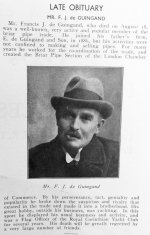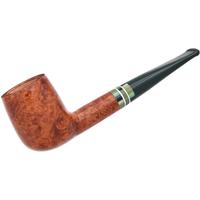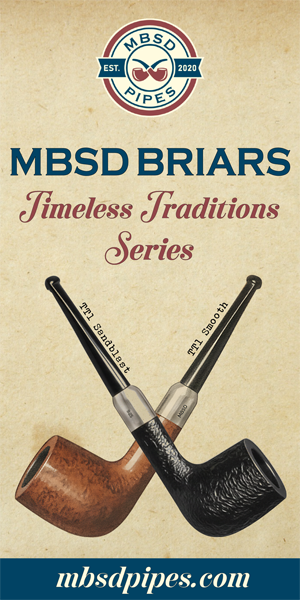Help: 1910 LPC London Made "Extra" Bulldog
- Thread starter Humblepipe
- Start date
You are using an out of date browser. It may not display this or other websites correctly.
You should upgrade or use an alternative browser.
You should upgrade or use an alternative browser.
Sorry about the delay gentlemen but it's been a busy week. Honestly I'm not sure but would guess that Ahi Ka is right, that the London Pipe Company made this pipe. Definitely not, in my opinion, O. L. Parker.
Acting on the assumption your pipe was made by the London Pipe Company I can tell you a little bit about the company's background. The story is actually pretty tangled so this will just have to be the cliff notes version. Despite an intriguing reference suggesting the business dated to 1837 for various demonstrable reasons I frankly don't believe it; at best the early date refers to a parent or related company controlled by the same family (which in this case was the de Guingands) or more likely a predecessor. As for the LPC itself I suspect it was established in the early years of the 20th century. In any case it converted to a limited liability company in April of 1917 and was thereafter referred to as the London Pipe Co Ltd. The owners were the de Guingand family, one of the more obscure players in the English and French briar pipe industry by today's standards but well-known to the trade in their day. At least as far as the UK was concerned the dynasty was founded by Emile Emanual de Guingand (1831-1912), who was born in France but moved to England in 1854. There he married Pauline Eugenie (1845-1914) in 1865 and together they had two sons and a daughter. Both sons followed their father into the pipe business; they were Paul Camille (1869-1943) and Francis Jules (1868-1935). It is these sons whose names are on the 1917 Memorandum and Articles of Association for the newly formed London Pipe Company Ltd.
It's worth pointing out that the father, Emile, had acquired interests in several briar pipe factories in France in the latter part of the 19th century (this is one of the parts I'm going to blip over since it gets pretty tangled and is tangential to the story). It's also worth pointing out that the family, represented by Francis, played a small but noticeable role in the formation of Cadogan in 1928. In July of that year the first round of the merger took place: the Salmon and Gluckstein families contributed Civic (which they had founded, sold to Imperial, and bought back again after WW1), Loewe, and La Bruyere in return for 36.3% of the common stock; the Adler family contributed the various Oppenheimer entities (including Frankau / BBB), Marechal Ruchon (i.e. GBD), H. Perkins, and a lesser company in Montreal in return for 40.6% of the common; and the de Guingand family contributed E. de Guingand & Son, E. de Guingand & fils (St Claude), and the London Pipe Co Ltd in return for 8.6% of the common. A few quick observations. First, the ratio between the common granted to the de Guingands and the other two initial participants in the merger is a reasonable shorthand for the relative magnitude of their businesses; in other words I'd expect the de Guingand companies to have been, in aggregate, only about 20-25% the size of the companies contributed by each of the two largest players. Second, the reason the numbers don't add up to 100% is that the rest of the common was issued in two subsequent transactions when Reiss Premier got involved later that year and when the Chapuis/Comoy families joined the party in early 1929. Third, there were preference shares issued at the same time but subject to a different allocation; again the bulk went to the two largest shareholders but the percentages were more or less flipped, strongly suggesting that the Salmon & Glucksteins were content to surrender a measure of control for a greater preferred interest in dividends and a more secured position in the event of insolvency. And finally, the surname of the de Guingand was spelled a variety of ways (DeGuingand, Deguingand, etc) in a variety of sources, so if you find the name spelled differently don't worry about it; it's still the same family.
As you can see from the shared history starting with the Cadogan merger the similarity in nomenclature between this pipe and Loewe and/or Frankau is intriguing. The problem of course is that the dates don't align; which is to say that Loewe, Frankau and the LPC was all under separate ownership in 1910.
By the way the London Pipe Company Ltd pops up in the 1922 litigation between Bartlett & Bickley and Dunhill over a little matter of a red spot that B&B had the temerity to put on their Barbic stems. Shortly before the lawsuit B&B (which won) had negotiated a deal with the London Pipe Co Ltd to produce their Barbic pipes for them, and inevitably the LPC was drawn into the fray.
I'm afraid that's all I have time for tonight. Just to repeat, I can't say the pipe is definitely an LPC, only that it seems plausible and I can think of no better candidate.
Cheers,
Jon
p.s. as a fun bit of trivia one of Francis' children was Francis Wilfred de Guingand. Francis (jr) grew up to play an important role during WW2 as a Major General and Chief of Staff to Field Marshal Montgomery during one of the most interesting parts of the war.
p.p.s. below is an obituary for Francis (sr) published in a trade journal shortly after his death:

Acting on the assumption your pipe was made by the London Pipe Company I can tell you a little bit about the company's background. The story is actually pretty tangled so this will just have to be the cliff notes version. Despite an intriguing reference suggesting the business dated to 1837 for various demonstrable reasons I frankly don't believe it; at best the early date refers to a parent or related company controlled by the same family (which in this case was the de Guingands) or more likely a predecessor. As for the LPC itself I suspect it was established in the early years of the 20th century. In any case it converted to a limited liability company in April of 1917 and was thereafter referred to as the London Pipe Co Ltd. The owners were the de Guingand family, one of the more obscure players in the English and French briar pipe industry by today's standards but well-known to the trade in their day. At least as far as the UK was concerned the dynasty was founded by Emile Emanual de Guingand (1831-1912), who was born in France but moved to England in 1854. There he married Pauline Eugenie (1845-1914) in 1865 and together they had two sons and a daughter. Both sons followed their father into the pipe business; they were Paul Camille (1869-1943) and Francis Jules (1868-1935). It is these sons whose names are on the 1917 Memorandum and Articles of Association for the newly formed London Pipe Company Ltd.
It's worth pointing out that the father, Emile, had acquired interests in several briar pipe factories in France in the latter part of the 19th century (this is one of the parts I'm going to blip over since it gets pretty tangled and is tangential to the story). It's also worth pointing out that the family, represented by Francis, played a small but noticeable role in the formation of Cadogan in 1928. In July of that year the first round of the merger took place: the Salmon and Gluckstein families contributed Civic (which they had founded, sold to Imperial, and bought back again after WW1), Loewe, and La Bruyere in return for 36.3% of the common stock; the Adler family contributed the various Oppenheimer entities (including Frankau / BBB), Marechal Ruchon (i.e. GBD), H. Perkins, and a lesser company in Montreal in return for 40.6% of the common; and the de Guingand family contributed E. de Guingand & Son, E. de Guingand & fils (St Claude), and the London Pipe Co Ltd in return for 8.6% of the common. A few quick observations. First, the ratio between the common granted to the de Guingands and the other two initial participants in the merger is a reasonable shorthand for the relative magnitude of their businesses; in other words I'd expect the de Guingand companies to have been, in aggregate, only about 20-25% the size of the companies contributed by each of the two largest players. Second, the reason the numbers don't add up to 100% is that the rest of the common was issued in two subsequent transactions when Reiss Premier got involved later that year and when the Chapuis/Comoy families joined the party in early 1929. Third, there were preference shares issued at the same time but subject to a different allocation; again the bulk went to the two largest shareholders but the percentages were more or less flipped, strongly suggesting that the Salmon & Glucksteins were content to surrender a measure of control for a greater preferred interest in dividends and a more secured position in the event of insolvency. And finally, the surname of the de Guingand was spelled a variety of ways (DeGuingand, Deguingand, etc) in a variety of sources, so if you find the name spelled differently don't worry about it; it's still the same family.
As you can see from the shared history starting with the Cadogan merger the similarity in nomenclature between this pipe and Loewe and/or Frankau is intriguing. The problem of course is that the dates don't align; which is to say that Loewe, Frankau and the LPC was all under separate ownership in 1910.
By the way the London Pipe Company Ltd pops up in the 1922 litigation between Bartlett & Bickley and Dunhill over a little matter of a red spot that B&B had the temerity to put on their Barbic stems. Shortly before the lawsuit B&B (which won) had negotiated a deal with the London Pipe Co Ltd to produce their Barbic pipes for them, and inevitably the LPC was drawn into the fray.
I'm afraid that's all I have time for tonight. Just to repeat, I can't say the pipe is definitely an LPC, only that it seems plausible and I can think of no better candidate.
Cheers,
Jon
p.s. as a fun bit of trivia one of Francis' children was Francis Wilfred de Guingand. Francis (jr) grew up to play an important role during WW2 as a Major General and Chief of Staff to Field Marshal Montgomery during one of the most interesting parts of the war.
p.p.s. below is an obituary for Francis (sr) published in a trade journal shortly after his death:

^^^^ Told ya. 
Jon's wayback machine is scary

Jon's wayback machine is scary
Sorry about the delay gentlemen but it's been a busy week. Honestly I'm not sure but would guess that Ahi Ka is right, that the London Pipe Company made this pipe. Definitely not, in my opinion, O. L. Parker.
Acting on the assumption your pipe was made by the London Pipe Company I can tell you a little bit about the company's background. The story is actually pretty tangled so this will just have to be the cliff notes version. Despite an intriguing reference suggesting the business dated to 1837 for various demonstrable reasons I frankly don't believe it; at best the early date refers to a parent or related company controlled by the same family (which in this case was the de Guingands) or more likely a predecessor. As for the LPC itself I suspect it was established in the early years of the 20th century. In any case it converted to a limited liability company in April of 1917 and was thereafter referred to as the London Pipe Co Ltd. The owners were the de Guingand family, one of the more obscure players in the English and French briar pipe industry by today's standards but well-known to the trade in their day. At least as far as the UK was concerned the dynasty was founded by Emile Emanual de Guingand (1831-1912), who was born in France but moved to England in 1854. There he married Pauline Eugenie (1845-1914) in 1865 and together they had two sons and a daughter. Both sons followed their father into the pipe business; they were Paul Camille (1869-1943) and Francis Jules (1868-1935). It is these sons whose names are on the 1917 Memorandum and Articles of Association for the newly formed London Pipe Company Ltd.
It's worth pointing out that the father, Emile, had acquired interests in several briar pipe factories in France in the latter part of the 19th century (this is one of the parts I'm going to blip over since it gets pretty tangled and is tangential to the story). It's also worth pointing out that the family, represented by Francis, played a small but noticeable role in the formation of Cadogan in 1928. In July of that year the first round of the merger took place: the Salmon and Gluckstein families contributed Civic (which they had founded, sold to Imperial, and bought back again after WW1), Loewe, and La Bruyere in return for 36.3% of the common stock; the Adler family contributed the various Oppenheimer entities (including Frankau / BBB), Marechal Ruchon (i.e. GBD), H. Perkins, and a lesser company in Montreal in return for 40.6% of the common; and the de Guingand family contributed E. de Guingand & Son, E. de Guingand & fils (St Claude), and the London Pipe Co Ltd in return for 8.6% of the common. A few quick observations. First, the ratio between the common granted to the de Guingands and the other two initial participants in the merger is a reasonable shorthand for the relative magnitude of their businesses; in other words I'd expect the de Guingand companies to have been, in aggregate, only about 20-25% the size of the companies contributed by each of the two largest players. Second, the reason the numbers don't add up to 100% is that the rest of the common was issued in two subsequent transactions when Reiss Premier got involved later that year and when the Chapuis/Comoy families joined the party in early 1929. Third, there were preference shares issued at the same time but subject to a different allocation; again the bulk went to the two largest shareholders but the percentages were more or less flipped, strongly suggesting that the Salmon & Glucksteins were content to surrender a measure of control for a greater preferred interest in dividends and a more secured position in the event of insolvency. And finally, the surname of the de Guingand was spelled a variety of ways (DeGuingand, Deguingand, etc) in a variety of sources, so if you find the name spelled differently don't worry about it; it's still the same family.
As you can see from the shared history starting with the Cadogan merger the similarity in nomenclature between this pipe and Loewe and/or Frankau is intriguing. The problem of course is that the dates don't align; which is to say that Loewe, Frankau and the LPC was all under separate ownership in 1910.
By the way the London Pipe Company Ltd pops up in the 1922 litigation between Bartlett & Bickley and Dunhill over a little matter of a red spot that B&B had the temerity to put on their Barbic stems. Shortly before the lawsuit B&B (which won) had negotiated a deal with the London Pipe Co Ltd to produce their Barbic pipes for them, and inevitably the LPC was drawn into the fray.
I'm afraid that's all I have time for tonight. Just to repeat, I can't say the pipe is definitely an LPC, only that it seems plausible and I can think of no better candidate.
Cheers,
Jon
p.s. as a fun bit of trivia one of Francis' children was Francis Wilfred de Guingand. Francis (jr) grew up to play an important role during WW2 as a Major General and Chief of Staff to Field Marshal Montgomery during one of the most interesting parts of the war.
p.p.s. below is an obituary for Francis (sr) published in a trade journal shortly after his death:
View attachment 224893
I am grateful, Jon. Thank you for taking the time to respond and to provide such great detail. Somehow it is satisfying to know that the Internet does not have ALL the information needed to solve these kinds of mysteries. I understand that you "can't say the pipe is definitely an LPC", but this is close enough for me. Thank you, thank you, thank you!
Last edited:













